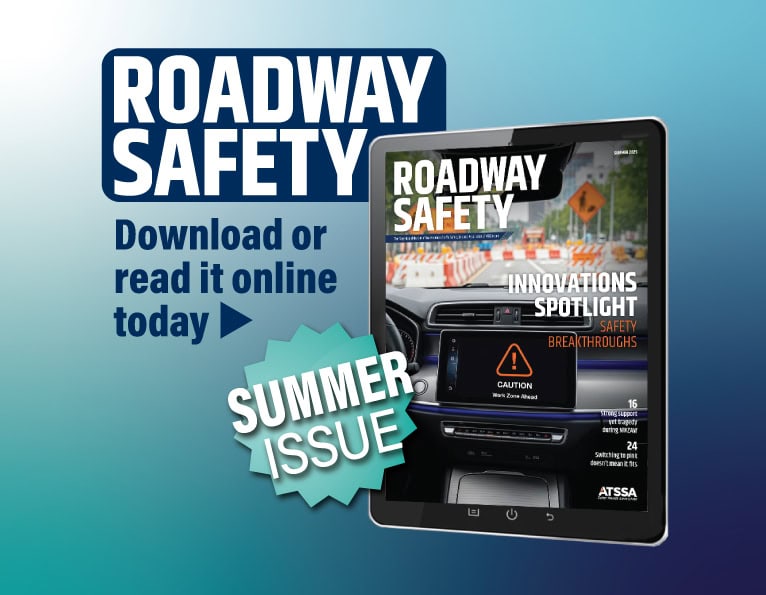MnDOT study examines driver preferences for pavement markings
By Nagham Matout El-Zine, ATSSA
The Minnesota DOT (MnDOT) recently published a study on pavement markings, examining driver preferences for pavement markings configurations, from a comfort and safety standpoint.
The findings of this study, “Pavement Marking Patterns and Widths – Human Factor Study,” led to forthcoming changes in MnDOT’s pavement markings standards, effective at the start of 2026. Here are some observations and key findings from the report:
Minnesota currently uses:
- 4-inch-wide center lines and lane lines
- 6 inch-edge lines
- Lane lines are 10 feet long, spaced 40 feet apart
- No contrast pavement markings
The configuration preferred by most drivers (based on the study):
- Lane line markings – 6 inches wide and 12.5 feet long, spaced 37.5 feet apart
- Preference for 6-inch-wide markings compared to 4-inch-wide markings
Impact: Effective at the start of 2026:
- MnDOT pavement markings standards will be updated reflecting longer and wider broken lane lines.
- MnDOT will put down lag contrast pattern (white followed by black) on concrete roads
The study also provides valuable information about pavement markings’ state of practice at different states:
Agencies with the same pavement marking width on all of their roads:
- 11 agencies typically use 4-inch wide
- 3 agencies typically use 5-inch, and
- 7 agencies typically use 6-inch.
- Pavement marking width varies for 31 agencies, with the larger width typically used on major routes and smaller width on minor routes.
From a safety standpoint, this study reinforces the benefits of wider pavement markings for both human drivers and vehicles equipped with safety features. It may also encourage other states to consider updating their standards or conduct their own study, which are both positive steps for roadway safety and industry.
Below is information from Table 1-6 from Page 34 of the report, which is a “Summary of Practice Regarding Pavement Marking Width.”
- Alabama
- 4–inch width is normal for both broken lines and solid lines
- 5– or 6–inch markings are optional at locations where a 4–inch line would be
used
- Alaska
- Lane lines, edge lines, center lines 4–inch–wide normal line
- Arizona
- Lane lines, edge lines, center lines are 6–inch wide
- Arkansas
- Normal lines are 4 to 6–inch wide
- California
- Lane lines, edge lines, center lines are 6–inch wide
- Colorado
- Lane lines, edge lines, are 6–inch wide except for multi–lane facilities with speeds of 45 mph or less
- Center lines are 4–inch wide
- Connecticut
- Lane lines, edge lines, center lines are 4–inch wide
- District of Columbia
- Normal lines are 4 to 6–inch wide
- Delaware
- A normal line along all roadways should be 5–inch wide
- Florida
- Lane lines, edge lines, center lines are 6–inch wide
- Georgia
- Lane lines, edge lines, center lines are 5–inch wide
- Hawaii
- A normal line is 4–inch wide
- Idaho
- Normal lines are 4 to 6–inch wide
- Illinois
- Normal lane lines, edge lines, center lines are 4 to 6–inch wide
- Iowa
- A normal line along all roadways should be 4–inch wide
- Indiana
- All center line markings shall be yellow in color and 4–inch wide
- Normal width lane line markings shall be white in color and shall be 5–inch wide on interstates and freeways, and 4–inch wide on other roads
- Edge line markings shall be 4–inch wide
- Kansas
- Normal lines are 4 to 6–inch wide
- Kentucky
- On interstates and parkways, and other routes approved by the State
Highway Engineer, install pavement striping that is 6 inches in width - On other routes, install pavement striping that is 4 inches in width
- On interstates and parkways, and other routes approved by the State
- Louisiana
- Normal lines are 4 to 6–inch wide
- Maine
- Unless otherwise shown on the plans, non–interstate all lines are 4 inches
wide - On controlled access divided highways and on the interstate system all lines are 6 inches wide
- Unless otherwise shown on the plans, non–interstate all lines are 4 inches
- Maryland
- A normal line along all roadways should be 5–inch wide
- Massachusetts
- Normal lines are 6–inch wide on all state highways
- Michigan
- Lane lines and center lines should be 4–inch wide
- Edge lines should be 6–inch wide
- Minnesota
- Normal lines are 4 to 6–inch wide
- Mississippi
- Normal lines are 6–inch wide
- Missouri
- Major routes: all white lines – 6–inch wide, yellow edge lines – 6–inch wide,
yellow centerline markings (including no passing zone markings) – 4–inch wide - Minor routes: white edge lines – 4–inch wide, all yellow center line markings (including no passing zone markings) – 4–inch wide
- Major routes: all white lines – 6–inch wide, yellow edge lines – 6–inch wide,
- Montana
- All lines are 4 inches wide
- Nebraska
- Normal lines are 4 to 6–inch wide
- Nevada
- Interstates and freeways require 8” wide edge line and lane line stripes
- For all other roadway types, edge line and lane lines are typically 6” wide
- New Hampshire
- Center lines are 4–inch wide
- Edge lines and lane lines on interstates are 6–inch wide, all other applications 4–inch wide
- New Jersey
- A normal line is 4–inch wide
- New Mexico
- 6–inch–wide lane lines on freeways and multilane freeways
- Other markings are 4 to 6–inch wide
- New York
- Normal lines are 4 to 6–inch wide
- North Carolina
- Edge lines, center lines, lane lines should be 4–inch or 6–inch wide
- Use 6–inch lines on all full control of access facilities and other routes as directed by the engineer
- North Dakota
- Normal lines are 4 to 6–inch wide
- Ohio
- Center lines should be 4–inch wide
- 6–inch lane lines should be used on interstates, freeways, multilane divided and undivided highways. 4–inch lane lines should be used on all other highways
- 6–inch edge lines should be used on interstates, freeways, multilane divided, undivided highways, and two–lane rural highways. 4–inch edge lines should be used on all other highways
- Oklahoma
- Normal lines are 4 to 6–inch wide
- Oregon
- Normal line – 4 inches wide
- Pennsylvania
- Lane, edge and center lines are 4–inch wide for two–lane two–way highway; for multilane highways they are 6–inch wide
- Puerto Rico
- Lane lines, edge lines, center lines are 6–inch wide
- Rhode Island
- All edge lines and skip lines should be 6 inches wide for expressways/freeways
- For all other roadways all white edge lines and skip lines shall be 6 inches and yellow center and edge lines should be 4 inches
- South Carolina
- On primary and secondary routes, edge lines and center lines are 4–inch wide
- On Interstate highways, solid edge lines, broken lines are 6–inch wide
- South Dakota
- A normal line is 4–inch wide
- Tennessee
- Edge lines and lane lines are 6–inch wide on controlled access facilities
- On conventional roads 45 mph or more 6–inch edge and lane lines, 40 mph or less 4–inch edge and lane lines, some exceptions
- Texas
- Lane lines, edge lines, center lines are 4–inch or 6–inch wide
- Utah
- Normal lines are 4 to 6–inch wide
- Vermont
- Normal lines are 4 to 6–inch wide
- Virginia
- Lane lines, edge lines are 6–inch wide for interstate highways and freeways; for other highways, lane lines, edge lines are 4–inch wide
- Washington
- Lane lines, edge lines, center lines are 4–inch wide
- West Virginia
- Lane lines, edge lines, center lines are 6–inch wide
- Wisconsin
- Normal lines are 4–inch wide
- Wyoming
-
A standard normal line width is 4–inch
-
Page 37 of the report includes Table 1-7, which provides the “Number of Agencies Using Different Marking Width.”
- Number of states using 4– inch normal marking
- 11 – Alaska, Connecticut, Hawaii, Iowa, Montana, New Jersey, Oregon, South Dakota, Washington, Wisconsin, Wyoming
- Number of states using 5–inch normal marking
- 3 – Delaware, Georgia, Maryland
- Number of states using 6–inch normal marking
- 7 – Arizona, California, Florida, Massachusetts, Mississippi, Puerto Rico, West Virginia
- Number of states where normal marking width varies (4 to 5–inch)
- 1 – Indiana
- Number of states where normal marking width varies (4 to 6–inch)
- 29 – Alabama, Arkansas, Colorado, District of Columbia, Idaho, Illinois, Kansas, Kentucky, Louisiana, Maine, Michigan, Minnesota, Missouri, Nebraska, New Hampshire, New Mexico, New York, North Carolina, North Dakota, Ohio, Oklahoma, Pennsylvania, Rhode Island, South Carolina, Tennessee, Texas, Utah, Vermont, Virginia
- Number of states where normal marking width varies (6 to 8–inch)
- 1 – Nevada
Data courtesy of MnDOT.
-Nagham Matout El-Zine is the manager of Innovation & Technical Services for ATSSA.
Published Date
May 12, 2025
Post Type
- News
Chapters
- Minnesota
- Northland
Related News Articles
August 14, 2025
Innovations spotlighted in Summer issue of Roadway Safety
Innovations spotlighted in Summer issue of Roadway Safety Safety breakthroughs developed for drivers, pedestrians and workers In effort to break…
August 13, 2025
USDOT offering $1 million in prizes for ‘Ideas & Innovation Challenge’
USDOT offering $1 million in prizes for ‘Ideas & Innovation Challenge’ Join Aug. 20 webinar for details on contest to…
August 4, 2025
Creative solutions, new technologies emerge at ATSSA’s Circle of Innovation
Creative solutions, new technologies emerge at ATSSA’s Circle of Innovation Industry benefits from annual gathering of public agencies documented in…


